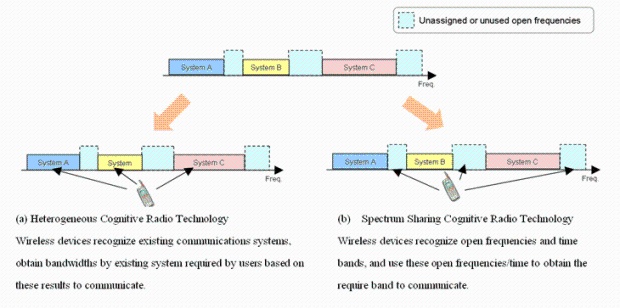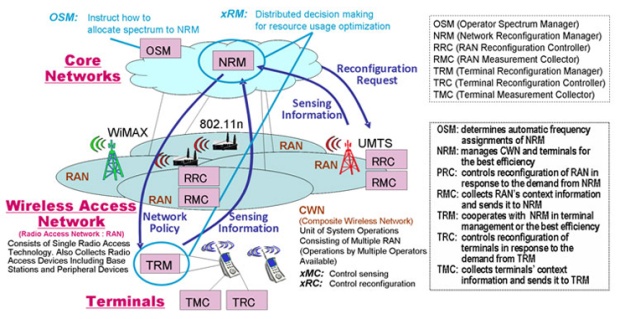More effective and efficient use of radio resources is required to enable higher speed, larger size and higher quality wireless communications in today's restricted radio use. Architecture for expanding system wide communications capacity through efficient frequency use and improving communications quality in different radio access networks have been evaluated for P1900.4.
Home > Press Release > IEEE 1900.4 Standard has been published
- The World’s First Specification for Fundamental Architecture of Cognitive Wireless Network -
The National Institute of Information and Communications Technology (NICT; Dr. Hideo MIYAHARA, President) has been active over two years in the IEEE P1900.4 Working Group for establishing the world's first standard for the fundamental architecture of cognitive wireless network architecture (hereafter, P1900.4) and has established this standard. The hope is that the standard will become the core architecture based on cognitive radio technology essential in defining wireless systems using high frequencies, and serve as core technology for handling wireless communications with the newest generation network architecture where NICT is primarily moving ahead with its evaluations.
NICT has been participating in the IEEE P1900.4 Working Group since it began in February 2007, contributed (proposed) a total of 163 items in a 21-month period (February 2007-November 2008), and overseen discussions. This has led to around half of all contributions made. The advanced use of radio resources can be achieved and the expectation for wide band, high quality and stable mobile communication is possible through the establishment of IEEE 1900.4 standard. NICT also plays the deputy chairman both of SCC41 (Standards Coordinating Committee 41), the top organization for P1900.4, and of P1900.4, as well as P1900.4 technical editor, while playing a central role in the creation of standardization documents. In addition, we supported conferences in Osaka in February and Tokyo in July 2008, and provided an environment for Japanese companies and universities to easily participate in the standardization conference.
We expect this standard to be used as core technology for using wireless communications in new generation network architecture that NICT is moving ahead with primarily on evaluations. We also anticipate 1900.4.1, 1900.4a and other standards to be established based on this established standard.
IEEE P1900.4 Working Group
The IEEE (Institute of Electrical and Electronic Engineers) is an association of electrical and electronics fields in the United States. It holds international conferences, issues papers, and establishes technical standards in the stated fields. SCC41 (Standards Coordinating Committee 41) is a standardization committee created under the IEEE to establish standards for elemental technology required in order to achieve a dynamic radio access network. Further, it was originally referred to as P1900; however, it was reorganized as SCC41 and continues on today. The P1900.4 Working Group established in February, 2007 is an organization that is part of the SCC41 Working Group for improving full wireless system reception capacity and service quality in environments where multiple wireless access technologies exist. In the SCC41, there is the P1900.4 Working Group discussed earlier, as well as P1900.1 that establishes terminology definitions, P1900.2 that establishes definitions for the coexistence methods for radio and interference waves and P1900.6 that establishes wireless sensing interfaces, and other working groups.
Cognitive Wireless Network
A cognitive wireless network is a radio access network using cognitive radio technology possessing features for selecting the radio access and network path suited to radio use conditions such as little interference from recognized usable wireless systems. The cognitive wireless network has two approaches based on “heterogeneous cognitive radio technology” and “spectrum sharing cognitive radio technology” as shown in the figure.

Cognitive Radio Technology
Cognitive radio technology is a wireless communications technology for transmitting, continuously working on efficient frequency use at a communications quality users require be at a desired communications size through the wireless device recognizing the radio environment, and the proper use of frequency bandwidth, timeslots and other wireless resources without interfering with other systems according to these conditions.
Different Radio Access Network
This is a network that assumes multiple different wireless systems will be used in combination (ex. 3G mobile phones and wireless LAN). Each wireless system differs in their respective strengths (ex. strong mobile communications, fast transmission speed, low power consumption), and is assumed to switch to the appropriate items according to the conditions and be used in multiple combinations. Seamless handover technology, handover technology between different wireless communication systems, etc. are being evaluated in order to switch between systems.
Technical Contact
Hiroshi HARADA, Group Leader /
Kentaro ISHIZU, Expert Researcher
Ubiquitous Mobile Communications Group
New Generation Wireless
Communications Research Center
Tel:+81-46-847-5098
Fax:+81-46-847-5110
E-mail: 
















E-mail: 
















Press Release Contact
Sachiko HIROTA, Specialist
Plublic Relations Office
Strategic Planning Department
Tel :+81-42-327-6923
Fax:+81-42-327-7587
E-mail: 



















Appendix
More effective and efficient use of radio resources is required to enable higher speed, larger size and higher quality wireless communications in today's restricted radio use. Research and development on cognitive radio technology focusing on commercialization is progressing globally in order to achieve this. Evaluations into wireless resource management and methods for effective use are also being evaluated in new generation network architecture where NICT is advancing research and development.
An environment where standards and standard interfaces are specified, and where multiple wireless systems can operate harmoniously, must be created in order to improve frequency use efficiency using this technology. NICT has worked to establish standardization for promoting the practical use and commercialization of this technology by companies as the only public research institute on information communications in Japan based on this perspective. Architecture for expanding the full system communications capacity and its communications quality through effective frequency use was evaluated for different radio access networks with the P1900.4. Twenty-three organizations comprising U.S., European and Asian hardware and software device manufacturers, cell phone carriers, universities and public research institutes (at final draft approval) joined together and held discussions from their respective viewpoints to establish core architecture standards for cognitive radio networks in the P1900.4.

The core architecture defined in these specifications is shown in the figure. These are generally classified and consist of core networks, radio access networks and terminals. This specification defines OSM and NRM for core networks, RRC and RMC for radio access networks, TRM, TRC and TMC for terminals, and defines their functions and interfaces.
NICT has participated in P1900.4 since it began in February 2007, has submitted more than 150 contributions and led the discussions. Around half of all contributions submitted in P1900.4 are those from NICT. NICT’s contributions have achieved the merging and development of ‘MIRAI' seamless handover technology, software wireless platform technology and other research achievements advanced from around the year 2000 with “Cognitive Wireless Clouds (CWC)” technology research achievements promoted from 2006. More advanced use of radio resources can be achieved, and improvements in mobile communication band, quality and stability can be anticipated through the establishment of P1900.4 standard.
NICT has contributed greatly to the administration of this standardization group beyond proposing and discussing. NICT plays the deputy chairman both of SCC41 (Standards Coordinating Committee 41), the top organization for P1900.4, and of P1900.4, and P1900.4 technical editor (all from 2008), while playing a central role in the creation of standardization documents. It also supported conferences in Osaka (together with KDDI R&D Laboratories) in February 2008 and in Tokyo (together with the Tokyo University of Science) in July 2008, providing an environment where it is easy for Japanese companies and universities to participate in standardization conferences.
Further technology evaluations and establishing standards are expected based on the established 1900.4 standard. The establishment of the P1900.4.1 Working Group for discussing interfaces and protocols based on 1900.4 architecture and the P1900.4a Working Group for discussing the expansion of Spectrum sharing cognitive wireless networks in this standard is being proposed based on the today’s established standards. Its use as wireless resource management and as a method for effective use is also expected for new generation network architecture.






